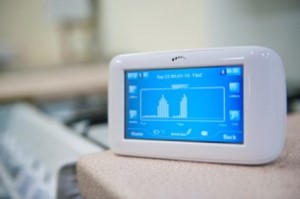Kilowatt hour
A watt (W) is a unit of electrical power. One watt represents a current of one ampere with a voltage of one volt.
A kilowatt hour (kWh or kW h) is a unit of energy that is equivalent to 1,000 watts (1 kW) of energy being transmitted or used for one hour. The kilowatt hour is commonly used by utility companies for pricing, calculating and communicating electricity energy bills to consumers.
One kilowatt hour is equal to 3.6 megajoules – the amount of converted energy if work is done at an average rate of 1 kW per hour.
The difference between a kW and a kWh is that a kW is the energy required for an appliance to function, whereas a kWh is the amount of energy that is actually used over a period of time.
For example, a 100 W light bulb would take 10 hours to consume 1 kWh of energy. A 50 W electrical appliance that is used at a constant rate for 20 hours would use 1 kWh of energy. A 2 kW electrical appliance would use 1 kWh in 30 minutes.
To calculate the cost of running an electrical appliance, the power consumption in kWh is multiplied by the price per kWh. The unit price of electricity often varies depending on the rate of consumption, the time of day, and the location.
[edit] Related articles on Designing Buildings Wiki
- Ampere.
- Conductor.
- Domestic micro-generation.
- Electricity.
- Energy.
- Glossary of electrical terms.
- Portable Appliance Testing (PAT).
- Power.
- Power generation.
- Smart meter.
- The future of electricity in domestic buildings, a review.
- The UK’s low-carbon future is increasingly electric.
- Voltage.
- Watt.
Featured articles and news
RTPI leader to become new CIOB Chief Executive Officer
Dr Victoria Hills MRTPI, FICE to take over after Caroline Gumble’s departure.
Social and affordable housing, a long term plan for delivery
The “Delivering a Decade of Renewal for Social and Affordable Housing” strategy sets out future path.
A change to adoptive architecture
Effects of global weather warming on architectural detailing, material choice and human interaction.
The proposed publicly owned and backed subsidiary of Homes England, to facilitate new homes.
How big is the problem and what can we do to mitigate the effects?
Overheating guidance and tools for building designers
A number of cool guides to help with the heat.
The UK's Modern Industrial Strategy: A 10 year plan
Previous consultation criticism, current key elements and general support with some persisting reservations.
Building Safety Regulator reforms
New roles, new staff and a new fast track service pave the way for a single construction regulator.
Architectural Technologist CPDs and Communications
CIAT CPD… and how you can do it!
Cooling centres and cool spaces
Managing extreme heat in cities by directing the public to places for heat stress relief and water sources.
Winter gardens: A brief history and warm variations
Extending the season with glass in different forms and terms.
Restoring Great Yarmouth's Winter Gardens
Transforming one of the least sustainable constructions imaginable.
Construction Skills Mission Board launch sector drive
Newly formed government and industry collaboration set strategy for recruiting an additional 100,000 construction workers a year.
New Architects Code comes into effect in September 2025
ARB Architects Code of Conduct and Practice available with ongoing consultation regarding guidance.
Welsh Skills Body (Medr) launches ambitious plan
The new skills body brings together funding and regulation of tertiary education and research for the devolved nation.
Paul Gandy FCIOB announced as next CIOB President
Former Tilbury Douglas CEO takes helm.
UK Infrastructure: A 10 Year Strategy. In brief with reactions
With the National Infrastructure and Service Transformation Authority (NISTA).























